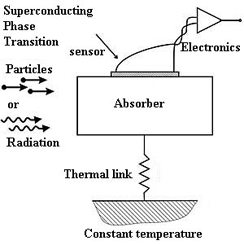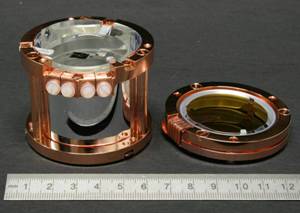|
The CRESST Dark Matter Search
CRESST (Cryogenic Rare Event Search with Superconducting Thermometers) is a dark matter search experiment involving the
Max-Planck-Institut für
Physik in Munich, the
University of Oxford , the
Technische
Universität München, the
Eberhard Karls
Univeristät in Tübingen and the
Laboratori Nazionali del Gran Sasso.
The experiment searches for the elastic scattering of dark matter particles off
atomic nuclei, using cryogenic detectors, operating at 10–15mK temperature. A
particle collision inside a detector creates a large number of phonons inside an
absorber crystal, these thermalise inside a superconducting thermometer on the
surface of the crystal. As the thermometer is biased in centre of its
superconducting transition, this small increase in temperature, produces a
relatively large change in resistance, which is then read out. To reduce the background rate
the experiment is located in hall A of the underground Laboratori Nazionali del Gran Sasso (LNGS).
CRESST phase I ran until 2001 using 262g sapphire detectors. The experiment was
then upgraded to CRESST II using a new design of cryogenic phonon scintillation
detector.
The CRESST II detector modules use 300g scintillating absorber crystals (CaWO4
or ZnWO4). In addition to the thermometer on the crystal surface, an
additional cryogenic scintillation light detector
measures the scintillation light produce by an interaction. The module is
enclosed in a reflective housing. By comparing these two signals, we can
distinguish electron recoil events (which provide more scintillation light) from
nuclear recoils. As WIMPs are expected to scatter off nuclei, we can reject the background from α, β, and γ
events which cause electron recoils. To avoid the remaining background from
neutrons, we have installed a polyethylene shield.
The experiment is now running with this improved setup. The results of a
preliminary commissioning run have allowed us to set a limit on the WIMP
scattering cross-section of 4.8×10-7pb.
The main contributions of the Oxford group towards the experiment have been
developing the data analysis software; investigating
scintillation materials; and developing the 66-channel
SQUID readout.
More information on CRESST can be found on the collaboration homepage: http://www.cresst.de.
CRESST Publications
Extending the
CRESST-II commissioning run limits to lower masses, Andrew Brown, Sam Henry,
Hans Kraus, and Christopher McCabe, Phys. Rev. D 85 (2012) 021301(R).
Commissioning
Run of the CRESST-II Dark Matter Search, G. Angloher et al., Astroparticle
Physics 31 (2009) 270,
arXiv:0809.1829.
Limits on WIMP
dark matter using scintillating CaWO4 cryogenic detectors with active
background suppression, G. Angloher et al., Astroparticle Physics
23 (2005) 325 – 339.
arXiv:astro-ph/0408006v3
Detection of the Natural Alpha Decay of Tungsten,
C. Cozzini et al.,Physical Review C 70 (2004) 064606.
arXiv:nucl-ex/0408006v2
|
|
 |
Gran Sasso, Italy
|
 |
The operating principle of a cryogenic calorimeter.
|

|
| A CRESST II detector module |
|




